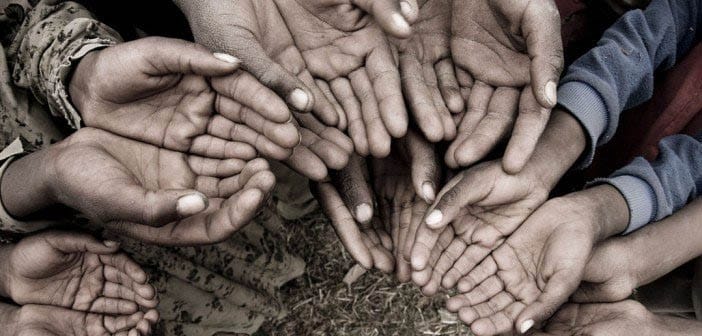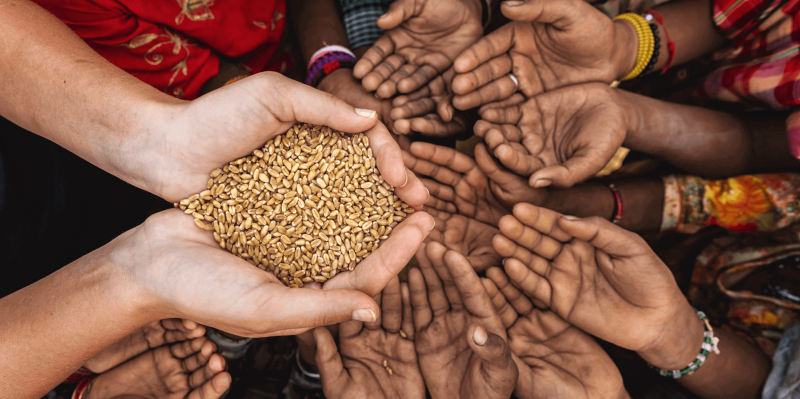Temporary Food Solutions During Personal Crises
When a personal crisis strikes, putting food on the table can suddenly become a daunting challenge. From job loss to unexpected expenses, life’s curveballs may leave many struggling to maintain consistent and nutritious meals for themselves and their families.
Food insecurity creeps in silently, but its impact is loud, affecting physical health and emotional well-being.
Did you know that in 2020 alone, an astonishing 13.8 million households faced this reality? While long-term solutions are vital, immediate steps are needed when hunger is at your doorstep.
This article will guide you through creating temporary food safety nets during these hard times with practical tips and accessible resources. Discover how quick actions can provide relief so that no one has to go to bed hungry tonight—read on for sustenance strategies that might be lifesavers.
Key Takeaways
- During personal crises, accessing nutritious food can be challenging. Exploring immediate food safety nets and resources, such as SNAP benefits, local food pantries, school meal programs, and community gardens is crucial.
- Food crises can lead to significant negative impacts on health and well-being. Understanding the costs associated with food insecurity, including household expenses, healthcare costs, productivity loss, emergency aid, agricultural investment needs, and market instability, is essential for effective policy responses.
- Developing economies are particularly vulnerable to food inflation and supply shortages. Conflict disrupts agricultural production and affects farmers in fragile states. Sustainable solutions are urgently needed to address these vulnerabilities.
- The financial toll of acute food crises on countries includes increased spending on imports, lower government income at subnational levels due to revenue shortfalls during pandemics like COVID-19, greater government spending on emergency food programs, rising medical expenses due to surging malnutrition-related health issues that inflate healthcare costs borne by the state.
Understanding Food Crises

Food crises are situations in which communities or regions experience food shortages, significantly negatively impacting health, well-being, and social stability. These shortages can be caused by natural disasters, conflict, economic instability, and climate change.
Understanding the scope and severity of food crises is crucial for developing effective strategies to address them. By mapping the costs and vulnerabilities associated with food insecurity, we can identify areas that require immediate attention and support.
Definition of a food crisis
A food crisis happens when people can’t get enough good food. This can come from insufficient money to buy food or shops running out of important foods. When this happens, folks might be unable to eat well and stay healthy.
It’s a serious problem that can pop up quickly, like when crops don’t grow well or prices for food jump high.
Having steady access to nutritious meals is key for everyone’s health. A crisis hits hard, especially for families trying to make ends meet. This struggle with getting food leads us to examine how it changes lives and what resources exist to fight it.
Impact of food insecurity
Food insecurity means not having enough good food to stay healthy. It can cause big problems for people’s bodies and minds. People who don’t get the right foods may not grow well or get sick more often because their bodies lack important nutrients.
Kids can have difficulty learning and playing when hungry, which isn’t good for their future.
Living without enough food also makes people feel worried and sad. Families might have to choose between buying food or paying for a home and medicine. This stress hurts both adults’ and children’s health, leading to more doctor visits and higher medical bills.
Strong communities need everyone to have enough healthy food so they can work hard, learn, and take care of each other.
Related objectives and resources
Food insecurity can hurt your health in many ways. To help, there are goals and tools you can use.
- Learning about the Supplemental Nutrition Assistance Program (SNAP): This program gives money to buy food. Check if you can get SNAP benefits at the local welfare office or online.
- Finding local food pantries: These places give out free food. Use the internet or call a community center to find one nearby.
- Knowing about Women, Infants, and Children (WIC): Pregnant women and families with little kids can get special food help from WIC.
- Checking for school meal programs: Many schools give free breakfast or lunch to kids who need it.
- Using cash transfer programs: Some groups give money to families in need so they can buy food. Look for these programs in your area.
- Exploring community gardens: You might be able to grow your fruits and veggies. Ask at a library or city hall about finding a garden space.
- Learning safe cooking tips: Know how to cook foods right so you don’t get sick. Local health departments often teach classes on this.
- Understanding how Healthy People 2030 works: This plan aims to fix health problems like insufficient food. They have lots of information online.
- Asking for debt relief options: If you owe money, some places let you pay less so you can spend more on food. Banks or credit counselors can help with this.
- Getting advice on climate-smart farming: If you farm, learn how to grow crops even when the weather is tough. Agricultural experts offer tips on this.
Healthy People 2030 domains
Mapping the costs and vulnerabilities of food crises helps us understand the importance of prioritizing nutrition and healthy eating, a key domain of Healthy People 2030. These are the main domains of Healthy People 2030:
- Eliminate Health Disparities.
- Create Social, Physical, and Economic Environments that Promote Good Health for All.
- Promote Quality of Life, Healthy Development, and Well-being across all Life Stages.
- Achieve Health Equity, Eliminate Disparities, and Improve the Health of All Groups.
- Attain High-quality, Longer Lives Free from Preventable Disease, Disability, Injury, and Premature Death.
Mapping the Costs and Vulnerabilities

Mapping the costs and vulnerabilities of food crises is essential for understanding the extent of the problem. From estimating costs to analyzing fiscal impacts, these insights drive effective policy responses.
To delve deeper into how we can address food insecurity, continue reading for valuable strategies and solutions.
Estimating costs of food crisis
Understanding the scope and impact of a food crisis requires a clear view of the associated financial burdens. Rising food prices dramatically affect both individual households and nations as a whole.
| Cost Factor | Description | Impact |
| Household Expenses | Increased spending on food due to higher prices. | Strains budget, leading to reduced savings or increased debt. |
| Healthcare Costs | Poor nutrition can lead to health issues requiring medical attention. | Rises in healthcare spending and long-term health implications. |
| Productivity Loss | Mitigating hunger can affect job performance and school attendance. | Lowers economic output and educational achievements. |
| Emergency Aid | Costs for governments or NGOs to provide immediate food relief. | Redirects funds from other development or infrastructure projects. |
| Agricultural Investment | Need for investment in sustainable agricultural practices. | Requires upfront costs with long-term benefits that might be hard to finance during crises. |
| Market Instability | Fluctuations in food prices can destabilize markets. | Potentially leads to broader economic turmoil. |
These costs underscore the importance of swift action to alleviate food crises. The fiscal implications also emphasize the need to support food production and make agriculture more climate-resilient. Moving forward, policymakers should focus on fostering stability and ensuring the right resources are in place.
Effect on countries most exposed to insecurity
Countries most exposed to food insecurity suffer significant economic and social consequences. Developing economies with limited domestic staple crop production capacity are particularly vulnerable to food inflation and supply shortages.
Conflict disrupts agricultural production and affects farmers, exacerbating food insecurity in fragile and conflict-affected states. These impacts can lead to malnutrition, chronic diseases, and increased vulnerability of the poorest populations.
These vulnerabilities highlight the urgent need for sustainable solutions to address food crises and build resilience within these countries.
Mapping the Costs and Vulnerabilities:
Fiscal costs for affected countries
Understanding the financial toll on countries grappling with food crises is crucial, especially for those investing in improving their health. An acute food crisis not only affects individual nutrition and well-being but also imposes significant fiscal costs on national economies, which in turn can have further repercussions on healthcare systems and food supply chains.
| Cost Factor | Impact | Details |
| Import Costs | Increased Spending | Higher food and fertilizer import costs lead to an additional $9 billion in fiscal spending for highly food-insecure nations. |
| Revenue Decrease | Lower Government Income | As seen during the COVID-19 pandemic, subnational governments experience revenue shortfalls, intensifying fiscal strain. |
| Expenditure Increase | Greater Government Spending | Emergency food programs and support services necessitate unplanned government outlays. |
| Healthcare Costs | Rising Medical Expenses | Malnutrition and related health issues surge, inflating healthcare costs borne by the state. |
These financial burdens underscore the importance of robust policies and personal preparedness in facing temporary food crises. Individuals must consider the larger economic context when seeking food solutions during emergencies. Health-focused citizens can take action by supporting initiatives that reduce food insecurity and understanding the broader implications of such crises on society and the economy. Through awareness and active participation, people can help mitigate the fiscal costs associated with food crises that ultimately impact communities and nations worldwide.
Financial cost of addressing acute food insecurity
Transitioning from the strain on affected countries’ finances, we now delve into the financial implications of mitigating acute food insecurity. The funding required to alleviate immediate hunger poses a significant challenge, especially considering the 13.8 million households facing food insecurity in the United States alone during 2020. The cost encompasses emergency food provision, support services, and longer-term interventions to stabilize food access.
Below is an overview of the financial burden that addressing acute food insecurity entails:
| Aspect | Description | Estimated Cost |
| Emergency Food Services | Includes food banks, shelters, and meal programs. | Variation depending on region and demand. |
| Healthcare Costs | Food insecurity is linked to increased healthcare utilization and expenses. | Higher average costs compared to food-secure households. |
| Government Assistance Programs | Programs like SNAP provide food assistance to eligible individuals and families. | Billions of dollars at the federal level annually. |
| Education and Outreach | Informing the public about food resources and healthy eating. | Costs may include campaign development and community program funding. |
| Infrastructure Investment | Building and maintaining facilities for food storage and distribution. | Significant upfront costs with ongoing maintenance expenses. |
| Research and Development | Investing in sustainable solutions and interventions. | Long-term investments can vary widely based on the scope of projects. |
| Direct Support to Farmers | Subsidies and incentives to encourage local, sustainable food production. | Costs depend on the agricultural policies and market conditions. |
This table provides a snapshot of the multifaceted approach required to address food insecurity effectively. Each element carries its costs, contributing to the overall financial burden of fighting food crises. As individuals interested in better health, understanding these economic dimensions can fuel advocacy for more efficient and equitable food systems.
Policy Responses to Food Crises

Governments can address food crises by supporting vulnerable households, promoting international trade, supporting food production and distribution, and making agriculture more climate-resilient.
These policy responses can help mitigate the impact of food insecurity and ensure access to nutritious food during personal crises.
Supporting vulnerable households
It’s important to support vulnerable households during personal crises by providing access to nutritious food. Here are some key ways to do this:
- Implement programs that provide financial assistance or food vouchers to low-income families.
- Offer education and resources on budget-friendly yet healthy meal planning and preparation strategies.
- Collaborating with local food banks and community organizations to ensure consistent access to essential food items for those in need.
- Advocating for policy changes that address systemic issues contributing to food insecurity, such as affordable housing and fair wages.
- Promoting community gardens and urban agriculture initiatives to empower individuals to grow their fresh produce.
Promoting international trade
Promoting international trade helps improve access to a variety of nutritious foods. Open trade policies can address higher import costs for food and fertilizer during global food crises, reducing the impact on food supplies and prices.
This supports efforts to ensure people have better access to healthy foods, which is crucial for overall health and well-being.
Balancing opinions on global trade policies is vital in addressing the concerns related to trade, food security, and economic policy for developing countries. International collaboration is essential in creating sustainable solutions for improving food security worldwide.
Supporting food production and distribution
Ensuring support for food production and distribution is crucial to address food crises. This involves enhancing agricultural productivity, facilitating market access, and improving transportation infrastructure.
Investing in sustainable farming practices and empowering smallholder farmers can boost food availability while supporting local economies.
Efforts are also needed to enhance distribution networks, minimize food waste, and strengthen supply chains. Utilizing technology to streamline logistics and storage facilities can help ensure that nutritious foods reach those in need without delay.
Making agriculture more climate-resilient
Supporting food production and distribution is crucial, but making agriculture more climate-resilient is equally important. Climate change directly affects our food systems and security.
To ensure sustainable access to nutritious food, policies must prioritize climate adaptation in the agriculture sector. Sustainable agricultural productivity growth is vital for addressing the impacts of climate change on food production.
It’s necessary to reorient policies towards climate resilience while considering the trade-offs involved. Policymakers must weigh the benefits of resilience against the costs of intervention, balancing them for long-term food security.
Personal Strategies for Temporary Food Solutions

When facing a personal food crisis, it’s essential to prioritize safe cooking and handling practices. This includes knowing bacteria and safe cooking temperatures, practicing proper food sanitation, serving and storing food safely, obtaining necessary permits and meeting requirements, and transitioning quickly to sustainable food systems.
These strategies are crucial for ensuring individuals’ health and well-being during temporary food insecurity.
Awareness of bacteria and safe cooking temperatures
It’s important to know bacteria and safe cooking temperatures when handling food. This can help prevent foodborne illnesses and ensure the safety of meals. Here are some key points to keep in mind:
- Bacteria multiply rapidly in the temperature danger zone, which is between 40°F and 140°F (4°C and 60°C). It’s crucial to store perishable foods appropriately to minimize bacterial growth.
- Proper food handling and sanitation practices are essential for preventing cross-contamination and reducing the risk of foodborne illness. This includes frequently washing hands, utensils, and surfaces, especially after handling raw meat or poultry.
- Safe food serving and storage involve maintaining hot foods at a temperature above 140°F (60°C) and cold foods at a temperature below 40°F (4°C) to inhibit bacterial growth.
- It’s important to use a food thermometer to ensure that foods are cooked to safe internal temperatures, as this kills harmful bacteria.
- Quick action is vital to transition to sustainable food systems that prioritize safety and nutrition, especially during temporary crises.
Proper food handling and sanitation
Transitioning from being aware of bacteria and safe cooking temperatures, it is crucial to understand proper food handling and sanitation. Here’s a detailed guide to help you navigate through this essential aspect of food safety:
- Wash your hands thoroughly with soap and water before preparing or handling food, especially during personal crises when temporary food solutions are necessary.
- Use separate cutting boards for raw meat, poultry, seafood, and fresh produce to prevent cross-contamination.
- Ensure that all utensils and surfaces are cleaned and sanitized before use to avoid the spread of harmful bacteria.
- Cook foods to their recommended internal temperatures using a food thermometer to guarantee they are safe.
- Refrigerate perishable foods promptly at or below 40°F (4°C) to slow down the growth of harmful bacteria.
Safe food serving and storage
When serving and storing food, following safety guidelines to prevent illness is crucial. Here are essential tips for safe food handling and storage:
- Keep hot foods at 140°F or hotter and cold at 40°F or colder.
- Store perishable foods promptly in the refrigerator to maintain freshness and reduce bacteria growth.
- Use shallow containers for quicker cooling of leftovers before refrigerating.
- Thaw frozen foods in the refrigerator, under cold running water, or in the microwave, not on the counter.
- Label and date leftovers to track their freshness and discard any past-date items.
Obtaining necessary permits and meeting requirements
To ensure food safety during storage, preparation, and serving, it is crucial to obtain the necessary permits and meet requirements set by health authorities. Here’s what you should consider:
- Application Process: Begin by submitting an application for a temporary food permit from the relevant health authority in your area.
- Source Evaluation: Health inspectors will assess the safety of your food source to prevent potential health hazards.
- Food Handling Evaluation: Evaluation of food preparation steps, handling, and storage to protect public health is essential for compliance.
- Inspections: Be prepared for inspections by city, county, or public health district officials to ensure adherence to regulations.
- Location-Specific Permits: Different locations may have specific requirements; ensure you acquire all necessary permits accordingly.
- Compliance with Regulatory Bodies: Understand the guidelines set forth by regulatory bodies and ensure full compliance before commencing operations at any event or location.
- Adherence to Retail Regulations: If operating within a retail establishment, additional permits or permissions may be required from other agencies as per local regulations.
Importance of quick action and transition to sustainable food systems
When obtaining necessary permits and meeting requirements, it’s crucial to realize the urgency of transitioning to sustainable food systems. Quick action is paramount in addressing food crises and achieving long-term sustainability.
Sustainable food systems are essential for ensuring nutritious food access, reducing poverty, and building resilience to climate change. Urgent transformation is needed at individual and systemic levels to create sustainable solutions that benefit us all.
Social innovation is pivotal in enabling this transition by promoting new approaches, technologies, and policies that support sustainable agriculture and nutrition. Through quick action and dedication to sustainability, we can fortify our communities against future crises while promoting healthier lifestyles for individuals.
FAQs

1. What happens when people don’t have enough food during a crisis?
During a crisis, if people can’t get enough food, they may become food insecure or even face malnourishment because they lack the necessary groceries.
2. Why do some areas have less food than others?
Some areas might have less food due to racial and ethnic disparities, economic fallout from crises, or export restrictions that affect agricultural products.
3. Can anything be done to help improve access to food in tough times?
Countries can work on structural reforms and increase social spending that helps poorer people buy food; groups like the World Bank and G7 can also reduce poverty by helping with economic recovery plans.
4. How does climate change hurt our ability to find enough food?
Climate change affects how well plants grow and can lead to more disasters, which makes it hard for everyone to secure enough good-quality agricultural products for their meals.
5. Are there ways to avoid running out of important foods like wheat?
Countries should not stop sending out important crops like Ukrainian wheat too much; instead, finding ways to share what’s needed means fewer people will be hungry in places like Sub-Saharan Africa.
6. What are cash crops, and why could they be bad during a crisis?
Cash crops are plants grown mostly for selling rather than eating at home; this can cause problems if farmers only focus on those instead of growing different foods that help feed everyone daily.

